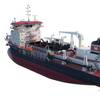Column: MarAd's CCF: Orphan Child Or Financing Solution?
By H. Clayton Cook, Jr., Senior Counsel Fulbright & Jaworski L.L.P.
When the Congress returns to Washington in September, the attention of the Members and of industry representatives will be focused on renewing authorizations for two important maritime programs, the MARAD Title XI Program, and the MARAD/DOD Military Security Program. However, there is a third MARAD program that is at least equally deserving of this September's attention, it is MarAd's Capital Construction Fund ("CCF") Program.
1. CCF Tax Deferral Program: History, Scope & Terms. The CCF Program traces its history to the Revenue Act of 1920. Title VI of the Merchant Marine Act, 1936 ("1936 Act") authorized the creation of "regular" and "special" reserve funds into which U.S. citizen liner operators, that were engaged in providing U.S. flag services on "essential" foreign trade routes, deposited earnings dedicated to the construction of vessels to be employed in these services. The Merchant Marine Act of 1970 ("1970 Act") expanded the program to include Alaska, Hawaii and Puerto Rico, and the Great Lakes, as qualifying trades.
The CCF Program allows vessel owners to accumulate the money for vessel purchases on a tax deferred basis under a MarAd Program contract. The deferral begins in the year in which an owner deposits vessel operating income in its fund, when it will reduce its vessel operating income for that year by the amount of the deposit. The tax deferral ends when the owner withdraws the money to finance the new vessel. When the new Program-financed vessel is placed in service, its cost basis will be reduced by the amount of its CCF tax deferred financing. The government then begins to recoup the tax deferred because of the taxpayer's reduced depreciation deductions.
When the CCF provisions were enacted as a part of the 1970 Act, the House and Senate committees reported that:
"It is believed that these provisions will do more than anything else in the bill to help the ship operating, and therefor the shipbuilding industry to build ships in United States yards which are so urgently needed to modernize our United States merchant marine."
The ensuing years have born out this prediction, witnessing CCF deposits in excess of $7.8 billion and withdrawals of some $5.9 billion for fleet modernization and expansion. Today there are more than 120 CCF fundholders with almost $1.9 billion on deposit. But, while the Program has been available for noncontagious services like Alaska and Hawaii, it has not been available for domestic contiguous coastwise services.
2. MarAd's March 2002 Proposals: Expand CCF to Coastwise Services.
On March 14th of last year, in testimony before the House Armed Services Committee, Maritime Administrator William G. Schubert proposed the expansion of the CCF Program to include the contiguous domestic trades and mobile offshore drilling units.
"[I]n an effort to free up capital already set aside, the Administration proposes some improvements to the Capital Construction Fund program. . . . The CCF Program enables operators to utilize private funds from company earnings to build vessels for the U.S. foreign trade, Great Lakes, noncontiguous domestic trade . . . of the Unites States.
"Our bill would also permit the use of deposits into a CCF for the construction or reconstruction of vessels to be used in the contiguous coastwise domestic trade. This amendment would make it possible to use capital already deposited in CCF for vessels for coastwise trade. These vessels such as ferries and cargo ships, will help alleviate passenger and freight congestion on major U.S. highways and commuter routes. CCF deposits, however, could not be used for vessels participating in the inland river trade. The proposal would also permit the use of CCF deposits for mobile offshore drilling units (MODUs)."
While the Office of Management and Budget (OMB) had cleared this MARAD testimony, subsequent Department of the Treasury opposition blocked submission of the proposals to the 107th Congress. MARAD included these proposals for consideration again as a part of FY 2004 budget discussions, and Treasury again blocked their submission to Congress.
3. The Shipbuilders Council of America Initiative.
In the fall of 2002, mindful of Treasury's history of CCF Program opposition, and concerned that MarAd would not be successful in obtaining OMB approval, Shipbuilders Council of America ("SCA") and Fulbright & Jaworski L.L.P. ("Fulbright") personnel decided that a plan should be developed for a Congressional CCF initiative. When it became apparent that OMB would not approve submission of the MarAd proposals to the 108th Congress, this plan was activated.
SCA and Fulbright believed that a CCF initiative along the lines of that proposed by MarAd would enjoy broad support within the U.S. shipbuilding and ship operating communities. The SCA and Passenger Vessel Association members designated the CCF initiative as one of their "first priority" legislative priorities for the 108th Congress. One of the most important owner-operators of U.S. coastwise product tankers became a supporter of record. It appeared that the other coastwise product tanker operators would support the SCA initiative once it had been presented and explained. Private sector proponents of start-up coastwise container and trailer movements had repeatedly characterized CCF and Title XI availability as essential for these cargo projects.
We expected support from senior members of the House Armed Services Committee and the Committee on Ways and Means, and from members of the Alabama, California, Florida, Mississippi, Pennsylvania and Texas delegations. We hoped that a carefully organized effort might assure enactment of the SCA proposals during the 108th Congress without regard to MarAd's achieving the Bush Administration's endorsement for Administrator Schubert's CCF proposals.
4. H.R. 2190: "The United States Maritime Industry Promotion Act of 2003."
The SCA/Fulbright CCF language, which tracked Administrator Schubert's March 2002 proposals, and then added offshore production units and shipyard dry docks, was passed through the House legislative drafting service, and introduced by Congressman James McCrery, (R-La.), as H.R. 2190, "The United States Maritime Industry Promotion Act of 2003," in late May.
Congressman McCrery, a Republican who represents Louisiana's 4th District, is a member of the Committee on Ways and Means, where he chairs the Subcommittee on Select Revenue Measures. H.R. 2190 has been referred to the Committee on the Armed Services and the Committee on Ways and Means, where we expect that the bill will be assigned to McCrery's Subcommittee.
McCrery has pledged his personal involvement in achieving H.R. 2190 enactment. The SCA, has done further work in developing a promising legislative strategy, which should assure the support of senior members in both the House and the Senate. Congressional staffs believe in the project to be meritorious. The task, which remains, is the marshaling of an industry effort that will attract the member support necessary to achieve H.R. 2190 passage.
5. Concluding Thoughts: All Should Support H. R. 2190.
Vessel operators can make use of the CCF Program in a number of ways. An operator can accumulate the money needed for new construction by deferring the tax, which would otherwise be due on current operating and investment income. Reductions in an operator's vessel purchase price can be achieved by teaming with an existing CCF fundholder. An operator's vessel cost can be reduced by using CCF monies to pay vessel debt. In leasing transactions, an operator can achieve reductions in demise charter hire by working with a lessor, which uses the CCF Program to shelter investment income from high yield investments. And, these savings can be significant, sometimes in the range of 10 to 20 percent of the basic, without CCF, payment figures.
Today there is almost $1.9 billion already deposited in taxpayer CCF accounts and set aside for shipbuilding. If the H.R. 2190 proposals are adopted, it seems likely that a substantial portion of this $1.9 billion will find almost immediate use in financing vessels to meet U.S. coastwise transportation and energy production needs. H.R. 2190 is an important, and perhaps a one time this decade, ship operator and shipyard opportunity. Mr. McCrery's office is seeking cosponsors for H.R. 2190. To date there have been fewer than half a dozen Member cosponsor additions. Isn't it time for all of us to step forward to provide the support for Mr. McCrery which will be necessary to achieve H.R. 2190 passage?
Mr. McCrery's H.R. 2190 deserves the support of everyone involved in the maritime sector.










